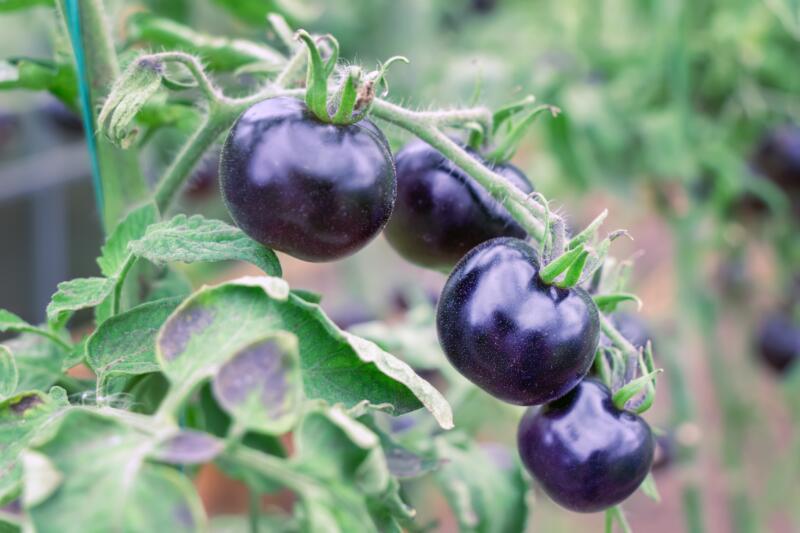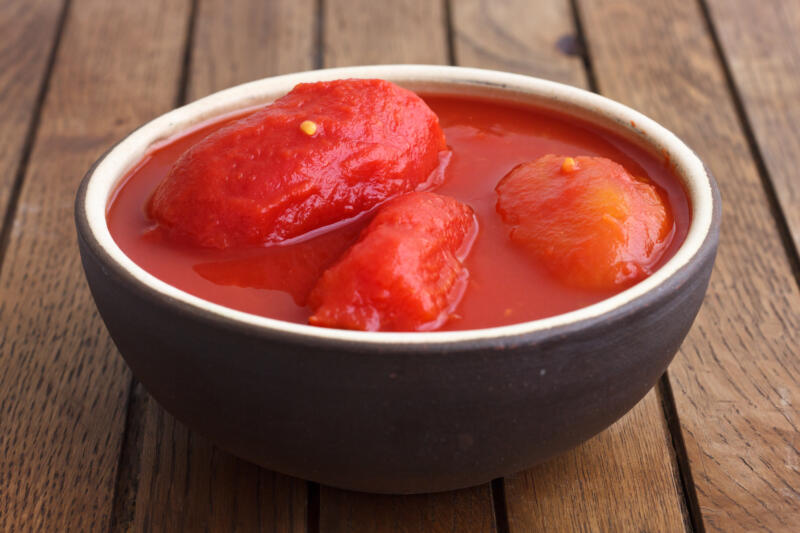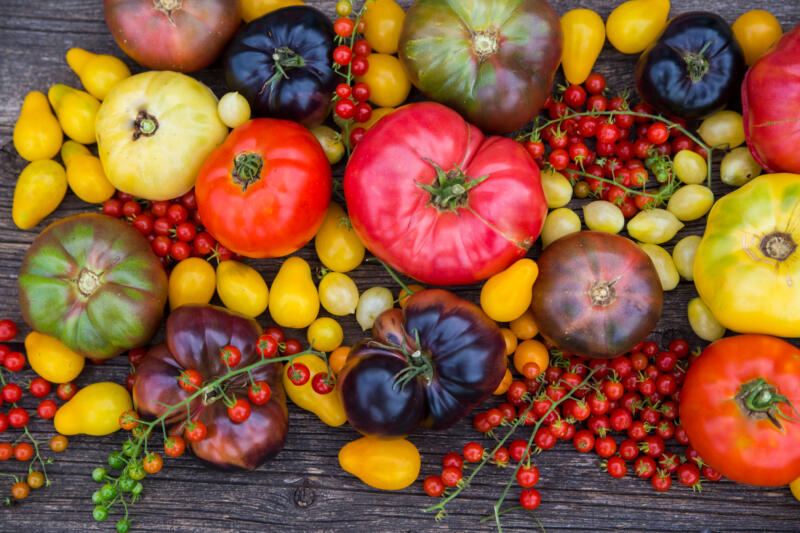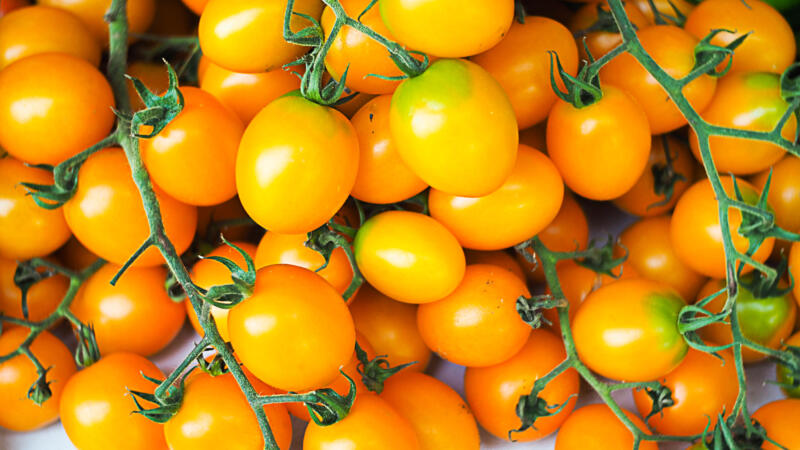As a food lover and an avid home cook, I’ve always been fascinated by the way ingredients interact in a dish. One ingredient that’s always intrigued me is the humble tomato.

Its versatility is truly remarkable, but it’s the tomato acidity level that can really make or break a dish.
Too much acidity and the dish can become overwhelmingly tart. Too little, and it might lack that characteristic tomato tanginess we all love.
In this article, we’ve explored the world of tomatoes and their acidity levels, from the factors that affect their acidity to the health benefits of low-acidic tomatoes.
In this article:
Overview of Tomatoes and Acidity
Tomatoes, a staple in many cuisines worldwide, are known for their vibrant color and versatile flavor.
But did you know that their distinct tanginess comes from their acidity levels?
Yes, tomatoes are naturally acidic, with a pH ranging from 4.2 to 4.9.
This acidity primarily stems from the presence of four types of acids: folic acid, citric acid, ascorbic acid (vitamin C), and malic acid.
There’s a wide variety of tomatoes, each with its unique acidity level.
For instance, cherry tomatoes are known for their sweetness, but they also have a higher acidity level compared to other types.
On the other hand, San Marzano tomatoes, often used in sauces, have a lower acidity level, making them a favorite among those who prefer a milder flavor.

But why should we care about the acidity in tomatoes? Well, consuming low-acidic tomatoes has several health benefits.
They are less likely to cause heartburn or acid reflux.
Plus, they can be a part of a balanced, alkaline diet, which some health experts believe can help maintain our body’s pH level.
How to Reduce the Acidic Level in Tomatoes
If you love tomatoes but find their acidity a bit too much for your palate or digestive comfort, don’t worry.
There are several ways to reduce the acidity levels in tomatoes, making them more enjoyable and easier on your stomach.
Add Baking Soda

Sprinkling a small amount of baking soda on your tomatoes can help neutralize their acidity.
Just remember to use it sparingly to avoid altering the tomato’s flavor too much.
Add Sugar
Adding a pinch of sugar can effectively counterbalance the acidity in tomatoes. This is a common trick used in making tomato-based sauces.
Add Carrots

Carrots are naturally sweet and can help offset the acidity in tomatoes.
Simply incorporate finely shredded carrots into your tomato-based dish, or you can add larger carrot pieces and remove them once the cooking process is complete.
Remove Seeds
The seeds and the surrounding gel contain a good amount of acidity. So, removing them can help reduce the overall acidity of your dish.
Types of Tomatoes and Their Acidity Levels

When it comes to tomatoes, the variety is vast, and so are their acidity levels.
From fresh to cooked, canned, and even processed into sauces or juices, each type of tomato and its preparation method can significantly impact its acidity.
Fresh Tomatoes

Fresh tomatoes, with their vibrant colors and flavors, are a delight to the senses.
They are perfect for making tomato sauce, offering a natural and less acidic taste compared to their canned counterparts.
Among the fresh varieties, cherry, grape, and Campari tomatoes are known to be sweeter and less acidic, making them a great choice for those who prefer a milder flavor.
During the summer, vine-ripened heirloom and beefsteak tomatoes come into their prime, offering a delicious option for homemade sauces. Their rich, full-bodied flavor can elevate any dish, making it a summer favorite.
Cooked Tomatoes

Cooking tomatoes can alter their acidity levels, often reducing them and making the tomatoes more palatable for those with acid reflux.
The different cooking methods, such as roasting, grilling, or simmering, can influence the acidity levels and bring out different flavors in the tomatoes.
Cooked tomatoes can be a great addition to various dishes, offering a depth of flavor while being gentler on the stomach.
Canned Tomatoes

Canned tomatoes are a pantry staple, offering convenience and versatility. They come in various forms, including whole, crushed, pureed, and diced, each with its unique texture and acidity level.
Keep in mind that canned tomatoes can be more acidic than fresh ones. This is because citric acid or other acids are often added to canned tomatoes to increase their shelf life and preserve their color.
The precise acidity can fluctuate based on both the brand and the variety of canned tomatoes used.
Tomato Products: Sauce, Juice, Etc.
Tomato products like sauces, juices, and others offer a convenient way to incorporate the flavor of tomatoes into your meals.
However, these products can have varying levels of acidity, which can affect individuals with acid reflux or sensitive stomachs.
It’s essential to read labels and choose products with lower acidity levels.
Despite their acidity, tomato products are packed with beneficial nutrients like lycopene, making them a healthy addition to your diet when consumed in moderation.
Factors That Affect Tomato Acidity Levels
According to a study from the National Center for Biotechnology Information, the pH level of tomatoes, indicative of their acidity, can vary based on several factors.
These factors include the tomato’s variety, maturity stage, and growing conditions.
1. Growing Conditions

The acidity levels of tomatoes can be significantly influenced by the conditions in which they are grown.
Several factors come into play here, including the water content, soil pH, and climate.
Starting with the climate, tomatoes grown in cooler climates often exhibit higher acidity levels.
This is because cooler temperatures slow down the tomato’s metabolism, leading to a build-up of organic acids. On the other hand, tomatoes cultivated in warmer climates tend to have lower acidity.
Soil pH is another crucial factor that can affect a tomato’s acidity.
Tomatoes thrive in slightly acidic soil, with an optimal pH range between 6.0 and 6.8.
The acidity of the soil can impact the availability of nutrients, which in turn influences the acidity of the tomato.
Lastly, the water content, determined by watering practices, plays a significant role in the acidity of tomatoes.
More water generally dilutes the concentration of acid in tomatoes, resulting in lower acidity levels.
2. Maturity Stage

As tomatoes ripen, their acidity decreases, and the storage conditions can influence this process.
To encourage ripening and reduce acidity, it’s beneficial to store tomatoes outside of the refrigerator.
Cold temperatures slow down the ripening process and may even alter the texture of the tomatoes.
Storing tomatoes at room temperature around 70 degrees Fahrenheit or 20 degrees Celsius is the best way to allow them to ripen and develop their full flavor.
3. Variety of the Tomatoes

Each type of tomato boasts a unique balance of sugar and acid, which shapes its distinct taste.
Heirloom tomatoes, for instance, are often noted for their relatively lower acidity compared to other types.
However, it’s essential to understand that the term “low-acid” in tomatoes might be slightly misleading.
Comprehensive research by the U.S. Department of Agriculture, which analyzed 58 different tomato varieties — including red, yellow, orange, hybrids, and heirlooms — revealed that the pH levels of tomatoes, indicative of their acidity, consistently range between 4.14 and 4.68.
This finding underscores that, regardless of the variety, all tomatoes have a relatively high inherent acidity.
The perception of some tomatoes being less acidic often stems from their elevated sugar content, which gives them a sweeter taste.
Thus, while certain varieties might seem milder due to their sweetness, their actual acidity remains fairly consistent across the board.
Low-Acid Tomatoes

Low-acid tomatoes have gained popularity not only for their reduced acidity but also for their distinct flavors and textures, making them a top choice for many gardeners and chefs.
However, it’s crucial to note that even though these varieties are labeled as “low-acid,” their pH levels remain relatively high.
As such, while they present a milder alternative, individuals with stomach sensitivities or issues related to acidic foods should approach them with caution.
The inherent acidity of these tomatoes might still be problematic for some.
Popular low-acid tomato varieties
- Pink girl: A low-acid variety that produces smooth, pink tomatoes weighing 6 to 8 ounces.
- Ponderosa pink: A beefsteak type that is almost seedless with low acid, weighing around 16 ounces.
- Big rainbow: A visually stunning tomato that matures into a gold-and-red sunset color, known for its rich flavor.
- Taxi tomato: A vibrant lemony-yellow tomato that grows to the size of a baseball, known for its low acid content.
- Golden jubilee: Introduced in 1943, this medium-sized beefsteak tomato has low acidity and high Vitamin C content.
- San Marzano: An heirloom variety known globally as one of the best for making tomato sauces, it is low in acidity and has a rich flavor.
4. Cooking Method

According to this study, the cooking method plays a significant role in the acidity levels of tomatoes.
Stewing appears to generally reduce the acidity in most ingredients, including tomatoes.
This is likely due to the dilution effect of the cooking liquid and the breakdown of acidic components during the longer cooking process.
Therefore, stewing tomatoes could be a beneficial method for those seeking to lower the acidity in their tomato-based dishes.
However, it’s important to note that the exact change in acidity can depend on various factors, such as the specific variety of tomato, the other ingredients in the dish, and the cooking duration.
5. Additives to the Recipe
When preparing tomato-based dishes, the additives you use can help manage the acidity levels.
For instance, sugar, carrots, and onions add sweetness to counteract the acidity, while baking soda neutralizes it.
Even citric acid, while acidic itself, can brighten the flavors and make the sauce taste less acidic.
Health Benefits of Eating Low-Acid Tomatoes
While “low-acid” tomatoes might not offer significant relief for those with sensitive stomachs or acid reflux due to their still relatively high pH levels, they do present other advantages.
Low-acidic tomatoes, due to their higher sugar content, can impart a naturally sweeter taste to sauces.
This can reduce or even eliminate the need for additional sweeteners, like sugar or carrots, that are often added to balance out the acidity in traditional tomato sauces.
Some low-acid tomato varieties have a meatier texture with fewer seeds and watery content. This can result in a thicker, smoother sauce, ideal for pasta dishes and pizza.
Additionally, regardless of their acidity, tomatoes are nutritionally rich.
They provide a rich supply of vitamins A and C, along with potassium and the antioxidant lycopene.
Lycopene has been associated with various health advantages, including a lowered risk of specific cancers, shielding against sunburn, and enhancing heart health.
So, while they might not be the solution for acid reflux sufferers, they remain a nutritious and flavorful choice for general consumption.
Considerations for Acid Reflux Sufferers
For individuals with acid reflux, the idea of consuming “low-acid” tomatoes might seem appealing.
However, it’s crucial to approach this with caution.
While certain tomato varieties are labeled as “low-acid,” studies have shown that their inherent pH levels remain relatively high.
This means that even these varieties might still pose challenges for some people with acid reflux.
The perception of reduced acidity in certain tomatoes is often due to their higher sugar content, which imparts a sweeter taste.
While tomatoes offer numerous health benefits, including potential improvements in gut health, those with acid reflux should consult with a healthcare professional before making significant dietary changes.
Tomatoes’ Nutritional Value
Tomatoes are abundant in vitamins, minerals, and antioxidants, all of which play a crucial role in promoting overall health and wellness.
One of the key nutrients found in tomatoes is vitamin C, an essential antioxidant that helps protect the body against free radicals.
Additionally, tomatoes are a good source of other vitamins like vitamin A, K, and several B vitamins, and minerals such as potassium and manganese.
A standout nutrient in tomatoes is lycopene, a powerful antioxidant responsible for their vivid red hue. Its connection to numerous health benefits, such as reducing the risk of heart disease and cancer, is noteworthy.
Interestingly, the lycopene they contain becomes even more available to our bodies after cooking, making dishes like tomato-based sauces and stews not only delicious but also healthful.
From supporting immune function to promoting heart health, the nutrients in tomatoes can cater to various aspects of your health. This makes them a nutritious and delectable choice for your meals.
Closing Thoughts
We’ve journeyed through the world of tomatoes, exploring their acidity levels, the factors that influence them, and the benefits of low-acidic tomatoes.
The acidity in tomatoes is not just about flavor—it can also impact our health and comfort.
From growing conditions to cooking methods, storage, and even the additives we use in our recipes, there are many ways to manage and reduce tomato acidity.
Experiment with different types of tomatoes, try new cooking methods, and see how it changes your culinary experience.
Whether you’re a seasoned chef or a kitchen newbie, don’t hesitate to ask questions or share your experiences. We’re all here to learn and grow together in our cooking journeys.